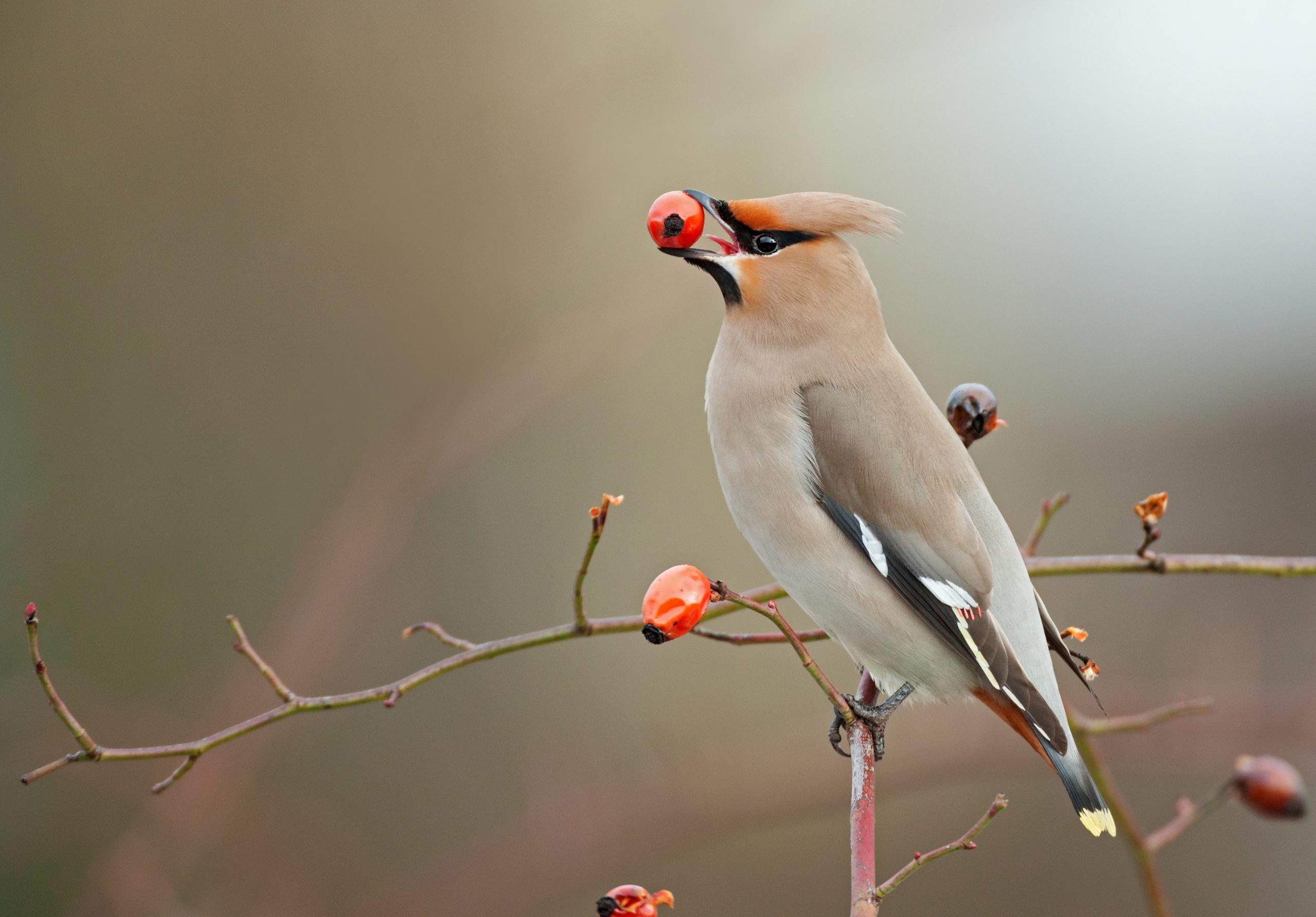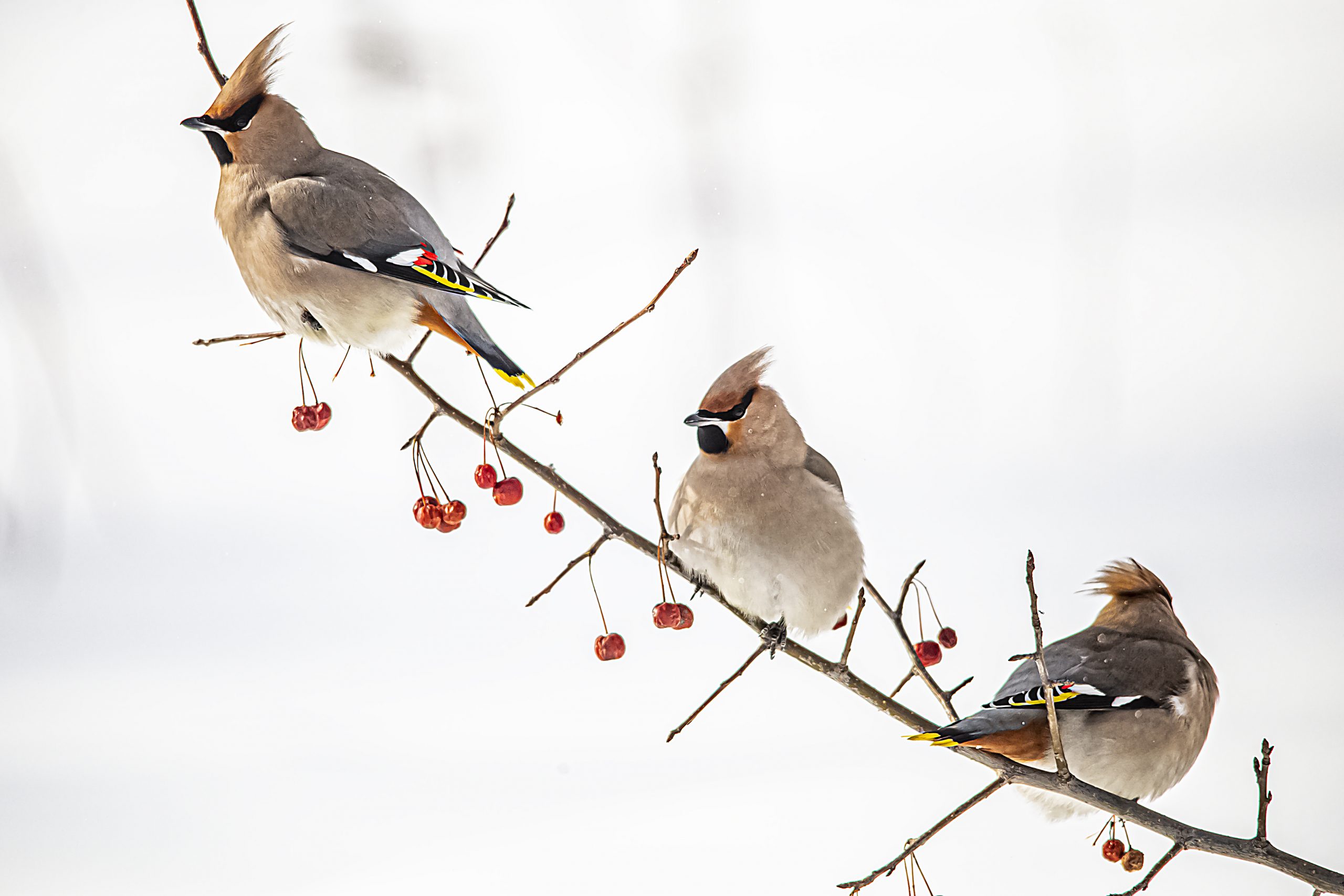Waxwings: The winter visitors which come to Britain so rarely they may never see a human again
Once thought to have presaged the First World War, these exquisite European songbirds are a blessing to our shores, says Mark Cocker.

As I stood this Christmas watching one of the largest flocks of Bohemian waxwings ever recorded in Derbyshire, I overheard someone say: ‘They are amazing. I wonder if I will ever see something like this again?’ I understood exactly what they meant.
The birds can sit for long minutes in treetops, where they seem stolid, silent and no more exciting than creatures the size and shape of common starlings. Then, suddenly, they erupt, swooping into bushes en masse to feed. In passages of intense activity, they clamber through the thorn, wings opening and closing, tails spread fan-like and strong feet clamping them to the flimsiest of twigs as they stretch, sometimes upside down, to reach for the furthest berries. In these moments, they remind me of tiny parrots.
Together with all this hectic activity, the thorn background allows the waxwing colours to ignite. They possess what is perhaps the most exquisitely structured plumage of any European songbird. Befitting an inhabitant of far-northern Scandinavia and Russia, the feathering is dense, almost fur-like, but of the softest, pinkish grey with touches of ginger and maroon. To these quiet shades, Nature has added delicate refinements: glorious saffron tips to its tail; lovely lines of white and lemon inscribed along the margins of the flight feathers; and then weird little knobs that look like sealing wax dripped onto the ends of several pinions. It is these crimson blobs, incidentally, that give the bird its name.
To cap it all are two further astonishing features, which suggest to me the extravagance of old aristocratic fashion. The bird’s ridiculously tall crest that has a hint of those perruque wigs once worn at Versailles; then, there is a thick black line sweeping around the bird’s head, evoking the eye cosmetics favoured by the queens of ancient Egypt.
"Regardless of the hubbub, the birds swooped down and moved at ease through the hedges"
This winter, thousands of people have been able to savour the minutiae of waxwing aesthetics. Large flocks dramatically appeared up and down the English and Scottish coastline last November, then panned out across Britain, notably in the Midlands. What determines these movements is the highly specialised nature of the waxwing’s winter diet.
More than any other bird, it depends upon the fruits of several trees, especially rowan and hawthorn. Cultivars of the first species seem the shrub of choice for many designers of supermarket car parks or the horticultural surrounds to petrol stations. In recent times, these berry-bearing bushes have lured waxwings right into the heart of our urban spaces.
This year, however, has also seen a bumper crop of hawthorn berries and the Derbyshire hedgerows, laden with crimson fruit, have been another powerful magnet. Over Christmas and New Year, near the town of Bakewell, there was a flock of 370 waxwings. By chance, a busy trail runs through this Derbyshire site and I recall wonderful moments when the place was heaving with people — joggers, cyclists, birdwatchers, photographers, but also families on a post-Christmas amble, with babies in prams and children or dogs playing excitedly.
Sign up for the Country Life Newsletter
Exquisite houses, the beauty of Nature, and how to get the most from your life, straight to your inbox.

Perhaps the most endearing of all waxwing qualities is a complete lack of fear of our species. Regardless of the hubbub, the birds swooped down and moved at ease through the hedges. Their calls are a soft, rippling bell-like note that is notable for a lack of fixed geographical source, so that the chorus produced by hundreds of them seemed to envelope everyone in a soothing soundscape. Waxwings, I realised, had involved us all — humans and birds — in one big mixed-species flock that seemed a rather wonderful way to recall some of the meaning of Christmas.
In The Go-Between, novelist L. P. Hartley reminds us that ‘the past is a foreign country’. Nowhere in ornithology does the sentiment have deeper meaning than in our historical attitudes towards these birds. Where we see something marvellous, our ancestors found deep anxiety. Waxwings were first recorded in the 16th century and from the Low Countries to Switzerland, Germany to the Balkans, their flocks were taken as omens of disaster. In Germany, the old names included todtenvogel (‘bird of death’) and pestilenzvogel (‘pestilence bird’). Even now, it is known in the Netherlands as pest vogel, which translates roughly as ‘plague bird’. There are dying echoes of those baleful connections as recently as the past century, when waxwing arrivals in the winter of 1913–14 were said to have foretold the First World War.
To unpick why our ancestors found all this avian charm so distressing, we have to look closer at the species’ ecology. Waxwings breed mainly north of the Gulf of Bothnia in Scandinavia, where the summer diet is almost exclusively insects, particularly mosquitoes, caught in swooping aerial assaults from treetops. If the northern weather is mild and favourable to breeding, waxwing numbers can increase and the range extend southwards roughly to the latitude of Stockholm.
Come autumn, the birds switch back to fruit and, when the berry crop is good, they move no further south than necessary. However, if it is in short supply or the birds’ numbers high because of nesting success and, finally, if fruit-loving thrushes — fieldfares and redwings — are also present in big numbers, the combined pressures push waxwings into so-called irruptive movements. It was the unexpected, unpredictable nature of these that aroused superstition among the human population. Add to this the fact that no one had ever recorded the species’ nest or eggs until the 1850s and you have some of the background to all that negative cultural baggage.
Today, we are learning how waxwings are more remarkable than we imagined. Among the Derbyshire flocks were several that had been banded with coloured rings by the Grampian Ringing Group. Two were first-year birds, born the previous summer and thus with no experience of Britain. Yet, after being tagged at New Elgin on November 13, they had flown more than 300 miles to spend Christmas in Derbyshire. Within days, one of them had uprooted again and re-appeared near Liverpool.
Imagine it: wandering through a completely unknown landscape, questing for ever-diminishing fruit supplies; stopping at supermarkets or packed car parks by motorways or in city centres, travelling onwards, occasionally to Ireland, France or even Spain. Yet, in its relatively long life — as much as 12 years — an individual may never have to make another journey like this. Once it returns to the seemingly limitless forests of the subarctic taiga, it may never see a human ever again. Waxwing appearances in our country are always, therefore, special. For one to be seen by so many people in the very heart of winter holidays is truly a kind of blessing.
-
 Two quick and easy seasonal asparagus recipes to try this Easter Weekend
Two quick and easy seasonal asparagus recipes to try this Easter WeekendAsparagus has royal roots — it was once a favourite of Madame de Pompadour.
By Melanie Johnson
-
 Sip tea and laugh at your neighbours in this seaside Norfolk home with a watchtower
Sip tea and laugh at your neighbours in this seaside Norfolk home with a watchtowerOn Cliff Hill in Gorleston, one home is taller than all the others. It could be yours.
By James Fisher